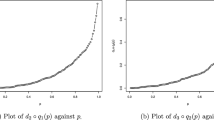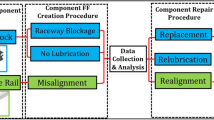Abstract
A new fault model, called the X-fault model, is proposed for fault diagnosis of physical defects with unknown behaviors by using X symbols. An efficient X-fault simulation method and an efficient X-fault diagnostic reasoning method are presented. Fault diagnosis based on the X-fault model can improve the accuracy of failure analysis for a wide range of physical defects in complex and deep submicron integrated circuits.
Similar content being viewed by others
References
Abramovici M, Breuer M, Friedman A. Digital Systems Testing and Testable Design. Computer Science Press, 1990.
Beh C et al. Do stuck fault models reflect manufacturing defects. In Proc. Int. Test Conf., 1982, pp.35–42.
Itazaki N, Idomoto Y, Kinoshita K. A fault simulation method for crosstalk faults in synchronous sequential circuits. In Proc. 26th Fault-Tolerant Computing Symp., 1996, pp.38–43.
Lavo D, Larrabee T, Chess B. Beyond the Byzantine generals: Unexpected behavior and bridging fault diagnosis. In Proc. Int. Test Conf., 1996, pp.611–619.
Maeda T, Kinoshita K. Precise test generation for resistive bridging fault of CMOS combinational circuits. In Proc. Int. Test Conf., 2000, pp.510–519.
Tahakashi H et al. Simulation-based diagnosis for crosstalk faults in sequential circuits. In Proc. Asian Test Symp., 2001, pp.63–68.
Mao W, Gulati R K. QUIETEST: A quiescent current testing methodology for detecting short faults. In Proc. ICCAD’90, Nov. 1990, pp.280–283.
Maxwell P, Aiken R. Biased voting: A method for simulating CMOS bridging faults in the presence of variable gate logic thresholds. In Proc. Int. Test Conf., 1993, pp.63–72.
Wen X et al. Fault diagnosis for static CMOS circuits. In Proc. Asian Test Symp., 1997, pp.282–287.
Boppana B et al. Multiple error diagnosis based on Xlists. In Proc. Design Automation Conf., 1999, pp.100–110.
Huang S. Speeding up the Byzantine fault diagnosis using symbolic simulation. In Proc. VLSI Test Symp., 2002, pp.193–198.
Author information
Authors and Affiliations
Corresponding author
Additional information
Xiao-Qing Wen received the B.E. degree from Tsinghua University in 1986, the M.E. degree from Hiroshima University in 1990, and the Ph.D. degree from Osaka University in 1993. From 1993 to 1997, he was a lecturer at Akita University. He was a visiting researcher at University of Wisconsin, Madison, U.S.A., from Oct. 1995 to March 1996. He joined SynTest Technologies, Inc., U.S.A., in 1998, and served as its CTO until 2003. From 2004, he has been an associate professor at Kyushu Institute of Technology, Iizuka, Japan. His research interests include VLSI test, diagnosis, and testable design. He is a member of IEEE.
Hideo Tamamoto received the B.E. degree in electronic engineering, the M.E. and D.E. degrees in electrical engineering from the University of Tokyo, in 1971, 1973 and 1976, respectively. In 1976, he joined the faculty of Akita University. Since 1993 he has been a professor in the Department of Computer Science and Engineering, Faculty of Engineering and Resource Science, Akita University, Japan. From 1996 to 1997, he was a visiting professor at the Electronic Engineering Department, Polytechnical University of Catalonia, Spain and at the Department of Electrical Engineering, the University of Iowa, U.S.A. His current research interests are testable design of logic circuits and current/thermal testing of CMOS logic circuits. He is a member of IPS, JSAI, SICE and IEEE.
Kewal K. Saluja obtained his B.E. degree in electrical engineering from the University of Roorkee, India in 1967, M.S. and Ph.D. degrees in electrical and computer engineering from the University of Iowa, Iowa City in 1972 and 1973 respectively. He is currently with the Department of Electrical and Computer Engineering at the University of Wisconsin-Madison as a Professor, where he teaches courses in logic design, computer architecture, microprocessor based systems, VLSI design and testing, and fault-tolerant computing. Prior to this he was at the University of Newcastle, Australia. Professor Saluja has held visiting and consulting positions at various national and international institutions including University of Southern California, Hiroshima University, Nara Institute of Science and Technology, and the University of Roorkee. He has also served as a consultant to the United Nations Development Program. He served as an Editor of the IEEE Transactions on Computers (1997--2001), and he is an associate editor for the letters section of the Journal of Electronic Testing: Theory and Applications (JETTA) published by Kluwer. Professor Saluja is a fellow of JSPS and a fellow of IEEE.
Kozo Kinoshita received B.E., M.E., and Ph.D. degrees in communication engineering from Osaka University in 1959, 1961, and 1964, respectively. From 1964 to 1966 he was an assistant professor and from 1967 to 1977, an associate professor of electronic engineering at Osaka University, Japan. From 1978 to 1989, he was a professor in the Department of Information and Behavioral Sciences, Hiroshima University, Japan. From 1989 to 2000, he again joined Osaka University as a professor in the Department of Applied Physics, and was a professor of Osaka University. Since April 2000, he has been a professor at Faculty of Informatics, Osaka Gakuin University, and is the Dean of Informatics. His fields of interest are test generation, fault diagnosis, memory testing, current testing, crosstalk testing, compact testing and testable design for logic circuits. He organized a series of Asian Test Symposium and was the Group Chair of Asian and Pacific Activities in Test Technology Technical Council of IEEE Computer Society until 2002. Prof. Kinoshita is IEEE Life Fellow and a member of the Institute of Information Processing of Japan. He was a member of the editorial board of JETTA until 2000.
Rights and permissions
About this article
Cite this article
Wen, XQ., Tamamoto, H., Saluja, K.K. et al. Fault Diagnosis of Physical Defects Using Unknown Behavior Model. J Comput Sci Technol 20, 187–194 (2005). https://doi.org/10.1007/s11390-005-0187-x
Received:
Revised:
Issue Date:
DOI: https://doi.org/10.1007/s11390-005-0187-x




